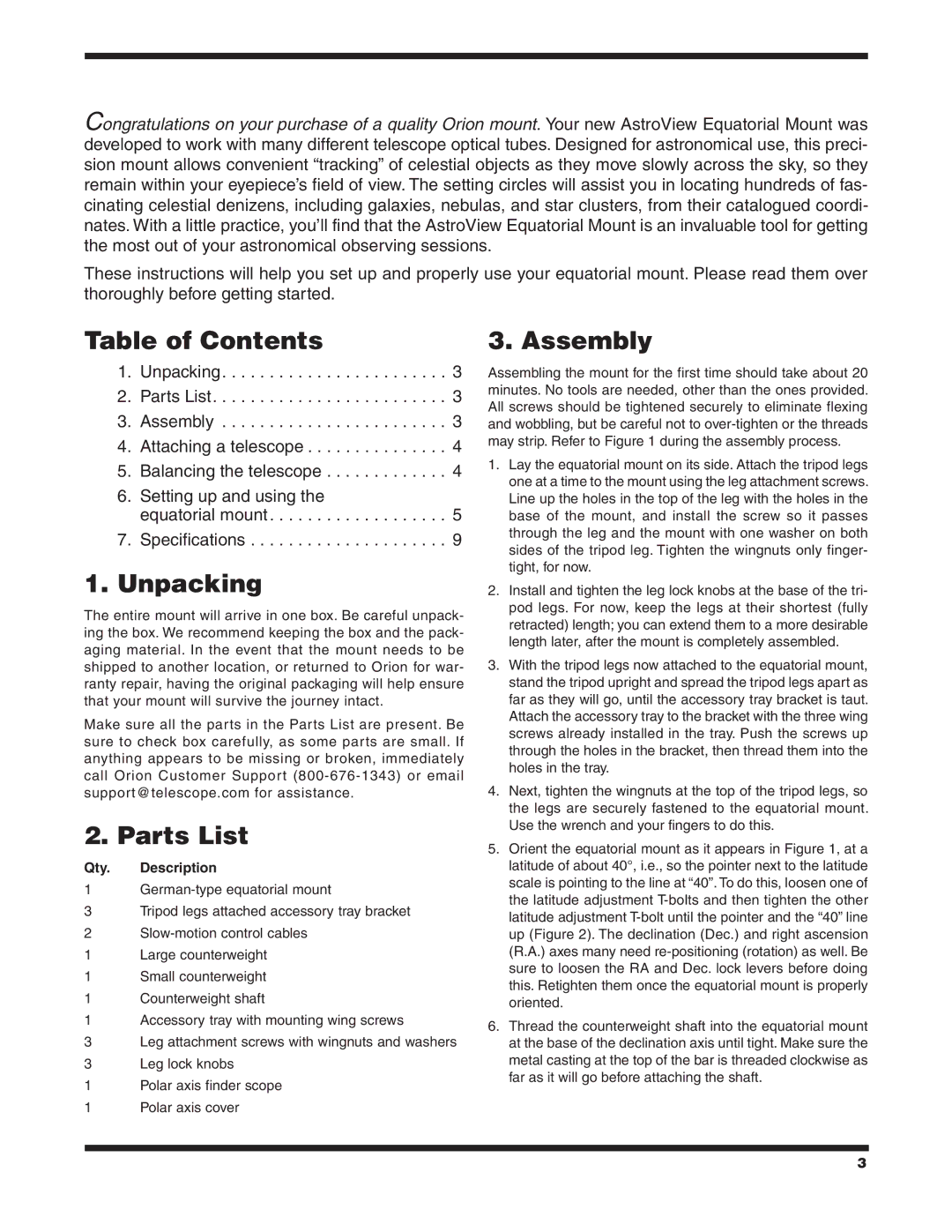
Congratulations on your purchase of a quality Orion mount. Your new AstroView Equatorial Mount was developed to work with many different telescope optical tubes. Designed for astronomical use, this preci- sion mount allows convenient “tracking” of celestial objects as they move slowly across the sky, so they remain within your eyepiece’s field of view. The setting circles will assist you in locating hundreds of fas- cinating celestial denizens, including galaxies, nebulas, and star clusters, from their catalogued coordi- nates. With a little practice, you’ll find that the AstroView Equatorial Mount is an invaluable tool for getting the most out of your astronomical observing sessions.
These instructions will help you set up and properly use your equatorial mount. Please read them over thoroughly before getting started.
Table of Contents
1. Unpacking . . . . . . . . . . . . 3
2. Parts List . . . . . . . . . . . . 3
3.Assembly . . . . . . . . . . . . 3
4.Attaching a telescope . . . . . . . 4
5.Balancing the telescope . . . . . . . 4
6.Setting up and using the
equatorial mount . . . . . . . . . 5
7.Specifications . . . . . . . . . . . 9
1.Unpacking
The entire mount will arrive in one box. Be careful unpack- ing the box. We recommend keeping the box and the pack- aging material. In the event that the mount needs to be shipped to another location, or returned to Orion for war- ranty repair, having the original packaging will help ensure that your mount will survive the journey intact.
Make sure all the parts in the Parts List are present. Be sure to check box carefully, as some parts are small. If anything appears to be missing or broken, immediately call Orion Customer Support
2. Parts List
Qty. Description
1
3Tripod legs attached accessory tray bracket
2
1Large counterweight
1Small counterweight
1Counterweight shaft
1Accessory tray with mounting wing screws
3Leg attachment screws with wingnuts and washers
3Leg lock knobs
1Polar axis finder scope
1Polar axis cover
3. Assembly
Assembling the mount for the first time should take about 20 minutes. No tools are needed, other than the ones provided. All screws should be tightened securely to eliminate flexing and wobbling, but be careful not to
1.Lay the equatorial mount on its side. Attach the tripod legs one at a time to the mount using the leg attachment screws. Line up the holes in the top of the leg with the holes in the base of the mount, and install the screw so it passes through the leg and the mount with one washer on both sides of the tripod leg. Tighten the wingnuts only finger- tight, for now.
2.Install and tighten the leg lock knobs at the base of the tri- pod legs. For now, keep the legs at their shortest (fully retracted) length; you can extend them to a more desirable length later, after the mount is completely assembled.
3.With the tripod legs now attached to the equatorial mount, stand the tripod upright and spread the tripod legs apart as far as they will go, until the accessory tray bracket is taut. Attach the accessory tray to the bracket with the three wing screws already installed in the tray. Push the screws up through the holes in the bracket, then thread them into the holes in the tray.
4.Next, tighten the wingnuts at the top of the tripod legs, so the legs are securely fastened to the equatorial mount. Use the wrench and your fingers to do this.
5.Orient the equatorial mount as it appears in Figure 1, at a latitude of about 40°, i.e., so the pointer next to the latitude scale is pointing to the line at “40”. To do this, loosen one of the latitude adjustment
6.Thread the counterweight shaft into the equatorial mount at the base of the declination axis until tight. Make sure the metal casting at the top of the bar is threaded clockwise as far as it will go before attaching the shaft.
3
